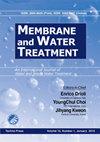膜生物反应器在模拟纺织废水处理中的性能评价
IF 0.8
4区 工程技术
Q4 ENGINEERING, CHEMICAL
引用次数: 0
摘要
浸没式膜生物反应器(SMBR)是通过将生物处理和膜分离相结合来实现高质量处理工业废水的最后技术之一。因此,本研究旨在评估SMBR处理模拟纺织废水(MTWW)的性能。研究了不同的SMBR操作参数,如混合液悬浮固体(MLSS)和溶解氧浓度、水力停留时间(HRT)和营养物质添加量(N和P)。使用活性偶氮染料Novacron blue FNG(100mg/L进料浓度)产生MTWW(SMBR的进水)。在最佳操作条件下(MLSS,4.2-13.3g/L;HRT,4天;pH,6.9-7.2;电导率,400-900µS/cm,温度,19.4-22.2°C),使用SMBR处理MTWW的结果表明,COD和蓝色处理性能分别在94-98%和30-80%之间。结果表明,SMBR可以应用于大型纺织废水处理厂,以提高出水水质,达到污水排放标准。本文章由计算机程序翻译,如有差异,请以英文原文为准。
Performance evaluation of submerged membrane bioreactor for model textile wastewater treatment
Submerged Membrane bioreactor (SMBR) is one of the last techniques that allow a high quality of treated industrial effluents by coupling biological treatment and membrane separation. Thus, this research was an effort to evaluate performance of a SMBR treating a model textile wastewater (MTWW). Different SMBR operating parameters like mixed liquor suspended solids (MLSS) and Dissolved oxygen concentration, hydraulic retention time (HRT), and nutrients addition (N and P) have been investigated. MTWW (influent to the SMBR) was generated using the reactive azo-dye, Novacron blue FNG (100mg/L feed concentration). Results of MTWW treatment using SMBR under optimal operating conditions (MLSS, 4.2-13.3g/L; HRT, 4 days; pH, 6.9-7.2; conductivity, 400-900 µS/cm and temperature, 19.4-22.2 °C) showed that COD and blue colour treatment performances are between 94-98% and 30-80%, respectively. It is concluded that SMBR can be used in large scale textile wastewater treatment plants to improve effluent quality in order to meet effluent discharge standards.
求助全文
通过发布文献求助,成功后即可免费获取论文全文。
去求助
来源期刊

Membrane Water Treatment
ENGINEERING, CHEMICAL-WATER RESOURCES
CiteScore
1.90
自引率
30.00%
发文量
0
审稿时长
>12 weeks
期刊介绍:
The Membrane and Water Treatment(MWT), An International Journal, aims at opening an access to the valuable source of technical information and providing an excellent publication channel for the global community of researchers in Membrane and Water Treatment related area. Specific emphasis of the journal may include but not limited to; the engineering and scientific aspects of understanding the basic mechanisms and applying membranes for water and waste water treatment, such as transport phenomena, surface characteristics, fouling, scaling, desalination, membrane bioreactors, water reuse, and system optimization.
 求助内容:
求助内容: 应助结果提醒方式:
应助结果提醒方式:


